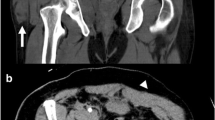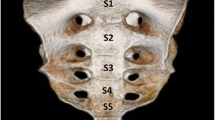Abstract
Purpose
The purpose of the study is to determine the incidence of sacral fracture patterns on CT imaging of pelvic trauma patients with correlation with mechanism of injury and pelvic ring injury pattern using the Young-Burgess classification system.
Materials and methods
This is a retrospective review of all pelvic CTs with pelvic fractures performed at our level 1 trauma center during a 4-year period from July 2010 to June 2014.
Results
Sacral fractures were very common in pelvic trauma patients, being present in 60% of patients presenting to our institution with pelvic fractures. Longitudinal fractures were almost always associated with additional pelvic ring injuries. Denis zone 1 fractures had the highest association with lateral compression pelvic ring injuries. Denis zone 2 and 3 fractures were seen with increased frequency in AP compression and vertical shear injuries. A third of transverse sacral fractures occurred in isolation, with isolated transverse sacral fractures typically occurring in the low (S3–S5) sacrum. Almost half of combined transverse and longitudinal sacral fractures occurred without an additional pelvic fracture present. Sacral avulsions almost always occurred as part of a pelvic ring fracture pattern, most commonly in AP compression injuries. Coccyx fractures frequently occurred in isolation, but were commonly seen in vertical shear injuries when associated with a pelvic ring injury pattern.
Conclusion
Avulsion fractures and longitudinal fractures of the sacrum are almost always associated with anterior pelvic ring injury. Conversely, transverse fractures of the lower sacrum and combined longitudinal and transverse sacral fractures are prone to occur in isolation.


Similar content being viewed by others
References
Bydon M, De la Garza-Ramos R, Macki M, Desai A, Gokaslan AK, Ali B (2014) Incidence of sacral fractures and in-hospital postoperative complications in the United States: an analysis of 2002-2011 data. Spine 39(18):e1103–e1109
Denis F, Davis S, Comfort T (1988) Sacral fractures: an important problem: retrospective analysis of 236 cases. Clin Orthop Relat Res 227:67–81
Hak DJ, Baran S, Stahel P (2009) Sacral fractures: current strategies in diagnosis and management. Orthopedics 32:752–757
Levine AM (2009) Fractures of the sacrum. In: Browner BD, Levine AM, Jupiter JB et al (eds) Skeletal trauma: basic science, management and reconstruction, vol 1, ed 4 edn. Saunders Elsevier, Philadelphia, pp. 1079–1106
Schmidek HH, Smith DA, Kristiansen TK (1984) Sacral fractures. Neurosurgery 15:735–746
Lehman RA, Kang DG, Bellabarba C (2012) A new classification for complex lumbosacral injuries. Spine J 12:612–628
Roy-Camille R, Saillant G, Gagna G, Mazel C (1985) Transverse fracture of the upper sacrum. Suicidal jumper’s fracture. Spine (Phila Pa 1976) 10:838–845
Strange-Vognsen HH, Lebech A (1991) An unusual type of fracture in the upper sacrum. J Orthop Trauma 5:200–203
Burgess AR, Eastridge BJ, Young JW, Ellison TS, Ellison PS Jr, Poka A, Bathon GH, Brumback RJ (1990). "Pelvic ring disruptions: effective classification system and treatment protocols". J Trauma 30 (7): 848–856
Bellabarba C, Stewart JD, Ricci WM, DiPasquale TG, Bolhofner BR (2003) Midline sagittal sacral fractures in anterior-posterior compression pelvic ring injuries. J Orthop Trauma 17(1):32–37
Albala C, Yanez M, Devoto E et al (1996) Obesity as a protective factor for postmenopausal osteoporosis. Int J Obes Relat Metab Disord 20:1027–1032
Felson DT, Zhang Y, Hannan MT, Anderson JJ (1993) Effects of weight and body mass index on bone mineral density in men and women: the Framingham study. J Bone Miner Res 8:567–565
Prieto-Alhambra D, Premaor MO, Fina Aviles F, Hermosilla E, Martinez-Laguna D, Carbonell-Abella C, Nogues X, Compston JE, Diez-Perez A (2012) The association between fracture and obesity is site-dependent: a population-based study in postmenopausal women. J Bone Miner Res 27(2):294–300
Compston JE, Watts NB, Chapurlat R, Cooper C, Boonen S, Greenspan S, Pfeilschifter J, Silverman S, Diez-Perez A, Lindsay R, Saag KG, Netelenbos JC, Gahlbach S, Hooven FH, Flahive J, Adachi JD, Rossini M, Lacroix AZ, Roux C, Sambrook PN, Siris ES, Glow Investigators (2011) Obesity is not protective against fracture in postmenopausal women: GLOW. Am J Med 124(11):1043–1050
Gansslen A, Pohlemann T, Paul C, Lobenhoffer P, Tscherne H (1996) Epidemiology of pelvic ring injuries. Injury 27(Suppl 1):S-A13–S-A20
Totterman A, Glott T, Madsen JE, Roise O (2006) Unstable sacral fractures: associated injuries and morbidity at 1 year. Spine 31(18):E628–E635
Gibbons KJ, Soloniuk DS, Razack N (1990) Neurological injury and patterns of sacral fractures. J Neurosurg 72:889–893
Mehta S, Auerbach JD, Born CT, Chin KR (2006) Sacral fractures. J Am Acad Orthop Surg 14:656–665
Park YS, Baek SW, Kim HS, Park KC (2012) Management of sacral fractures associated with spinal or pelvic ring injury. J Trauma Acute Care Surg 73(1):239–242
Robles LA (2009) Transverse sacral fractures. Spine J 9(1):60–69
Urzua A, Marre B, Martinez C, Ballesteros V, Ilabaca F, Fleiderman J, Zamorano JJ, Yurac R, Lecaros M, Munjin M, Lahsen P (2011) Isolated transverse sacral fractures. Spine J 11:1117–1120
Schildhauer TA, Bellabarba C, Nork SE, Barei DP, Routt ML, Chapman JR (2006) Decompression and lumbopelvic fixation for sacral fracture-dislocations with spino-pelvic dissociation. J Orthop Trauma 20:447–457
Siebler JC, Hasley BP, Mormino MA (2010) Functional outcomes of Denis zone III sacral fractures treated nonoperatively. J Orthop Trauma 24:297–302
Dussa CU, Soni BM (2008) Influence of type of management of transverse sacral fracture on neurological outcome. A case series and review of literature. Spinal Cord 46:590–594
Konig MA, Jehan S, Boszczyk AA et al (2012) Surgical management of U-shaped sacral fractures: a systematic review of current treatment strategies. Eur Spine J 21(5):829–836
Acknowledgements
We acknowledge the Memorial Hospital System in Houston.
We acknowledge the support provided by the Biostatistics/Epidemiology/Research Design (BERD) component of the Center for Clinical and Translational Sciences (CCTS) for this project. CCTS is mainly funded by a grant (UL1 TR000371) from the National Center for Advancing Translational Sciences (NCATS), awarded to University of Texas Health Science Center at Houston. The content is solely the responsibility of the authors and does not necessarily represent the official views of the NCATS.
Author information
Authors and Affiliations
Corresponding author
Ethics declarations
Conflict of interest
The authors declare that they have no conflict of interest.
Rights and permissions
About this article
Cite this article
Beckmann, N., Cai, C. CT characteristics of traumatic sacral fractures in association with pelvic ring injuries: correlation using the Young-Burgess classification system. Emerg Radiol 24, 255–262 (2017). https://doi.org/10.1007/s10140-016-1476-0
Received:
Accepted:
Published:
Issue Date:
DOI: https://doi.org/10.1007/s10140-016-1476-0




